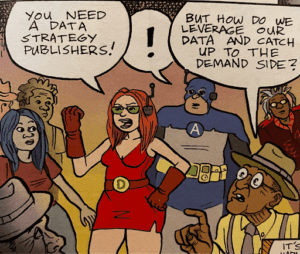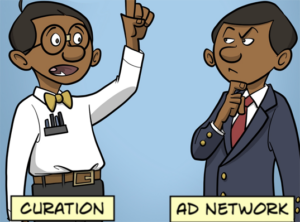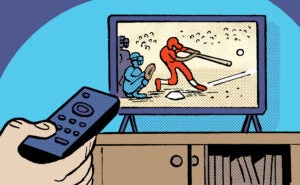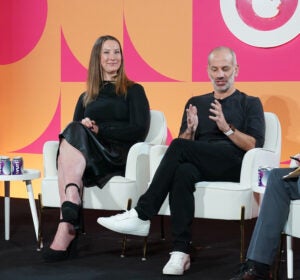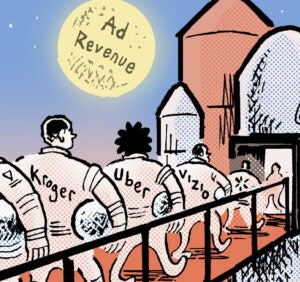 “The Sell Sider” is a column written for the sell side of the digital media community.
“The Sell Sider” is a column written for the sell side of the digital media community.
Today’s column is written by Tom Triscari, CEO of Labmatik.
Last year we saw material interest around top-of-waterfall solutions. This story continued simmering in 2016 with a thoughtful post by Jed Nahum comparing the two primary approaches, programmatic direct and header bidding, along with Google’s recent announcement of DFP First Look.
Jed is 100% correct. He essentially argued that programmatic direct does not give buyers what they want, specifically with audience and placement. In other words, buyers want the ability to reserve the best inventory via first look and ensure they are only buying exactly what they want. Since buyers cannot accomplish this objective using current manifestations of programmatic direct, they turn to a more populist solution called header bidding.
As the following table shows, header bidding guarantees almost nothing while programmatic direct still requires too much human intervention to be qualified as an automated solution. Then there is the notion of programmatic forwards or futures, which bring together the value of header bidding and the promise of programmatic direct giving both buyer and seller what they want.
| Programmatic Direct | Header Bidding | Programmatic Futures | |
| Inventory | seller defined | buyer defined | shared definition |
| Impressions | guaranteed | not guaranteed | guaranteed or non |
| Price | guaranteed | not guaranteed | guaranteed |
| Priority | guaranteed | fixed, but movable | order matching |
| Workflow | manual | automated | automated |
| Control | strong | weak | strong |
Why Bother With Automation?
It often feels like programmatic direct has always been a solution in search of a problem. It’s the right idea, but poorly implemented because current attempts don’t accomplish three key jobs for buyer and sellers.
First, current constructs do not solve the buyer’s need for high-quality, timely and scaled inventory description. Second, some solutions provide searchability, but they don’t add any real intelligence to the search. Finally, some solutions might deliver incremental automation to inserting reservations and line items, but this still requires too much human data entry. All in all, the prevailing solutions might reduce some manual data entry, but the actual costs of implementing them are likely greater than the business-as-usual manual workload today.
Even though header bidding is racing up the adoption curve, it is still a real-time auction for an impression with priority rights higher up in the waterfall. It’s certainly automated, but nothing is guaranteed, therefore buyer control – and often for sellers, too – is probably not optimal with respect to how serious buyers and sellers actually want to get the job done.
For buyers and sellers in the header bidding game, the size of their buys and the prices they are willing to pay drives their ability to participate. This is why the most widely overlooked issue with header bidding is about volume economics. For example, the main issue for large buyers is that real-time auctions, in the header or not, have no idea how big the entire media buy might be. The auction only knows the one bid for that one impression.
In reality, big buyers get good prices because of volume, big buyers need to know what they are buying and sellers need to understand the consequences of what they are selling. Neither programmatic direct or header bidding approach solves these fundamental economic constraints.
Finding Mutual Interest: What If?
Programmatic direct and header bidding sadly boil down to two ways of allocating inventory such that each one gives an advantage to one side or the other. Either way, each method forces a market structure where only one side can “win” the control game. It’s a classic example of negotiation theory that says outcomes for both parties are diminished when each side protects their respective position. So, rather than protect positions leading to worse outcomes for both parties, both sides can increase their respective payoff when they strike direct mutual interest.
So, if neither header bidding nor direct approaches lead to mutual benefit, then what will? What if there was a system that let the auction run before the impression shows up? What if the trade and the delivery process happened at different times? What if the concept of forward and futures was paired with header bidder, resulting in a flattened and complete waterfall?
This beautiful system of programmatic forward contracts traded in a biddable environment would allow buyers to have all the power they need to specify audiences, bid rational prices and allow publishers to specify contexts in ways that always match the buyer need. Such a system would bring the best of header bidding and programmatic direct into a single approach that actually gets the job done in a way that neither one on its own can accomplish.
In forward markets, buyers submit bids just like header bids, but with one critical difference. The bid must wait until the right inventory is available before transacting, thus giving the publisher the ability to show impressions, in the same way as first look, but in a much safer way for publishers and with intelligent search and description for advertisers. And unlike exposed ad server integrations, first look is offered to infinitely more demand sources without the need to encroach on the publisher’s ad server. Everybody wins. Nobody gets hurt.
If the ends justify the means, then do buyers and sellers really care who builds the solution that meets their most paramount needs? No, they couldn’t care less. All they care about are ways to automate what too many people do today at a scale that people could never do. They want the best of both programmatic direct and header bidding in a well-lit marketplace. The good news is that viable solutions such as Mass Exchange, C1X and others already exist, but too often big buyers and sellers don’t see the new forest for the established ad tech trees get in their way. All they have to do is look up and they will find a better way forward.
Follow Tom Triscari (@triscari) and AdExchanger (@adexchanger) on Twitter.



